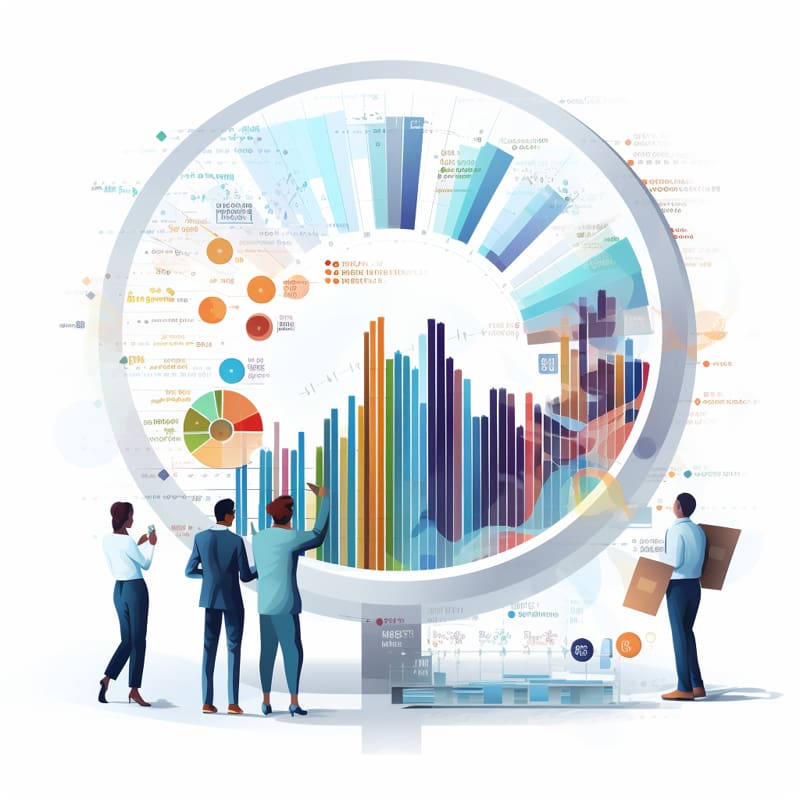Data Architect Interview Questions
Every interview provides an opportunity to demonstrate your abilities in data architecture, so our commitment is to give our guests the best experience.
Our blog hopes that providing and preparing these invaluable resources will lead to their success in interview settings.
Good Luck with all your interviews!

1. What is a Data Architect?
A Data Architect is designing and organising data structure and flow within an organisation.
It involves planning for the future and ensuring data is consistent and secure and can take advantage of modern data science methods.
2. Why is a Data Architect important in marketing decisions?
Data Architect plays a crucial role in marketing decisions by providing a map of the five steps acquisition, storage security, computation, and value creation.
It can be broken down into simple steps like Alice Brown’s website security, application on the ML, and value creation.
3. What are the properties of raw data?
Raw data is often viewed as structured, organised, and formatted predictably and consistently, making it easier to input, search, and manipulate.
Unstructured data, such as text, images, and audio formats, is often used to quantify and characterise data for business purposes.
4. What are the challenges of handling large files?
Handling large files can be challenging, especially when they are too big for Excel or Python.
A Data Architect who can handle increased volume and computation demands is necessary to manage these files effectively.
5. How can a simple company handle data?
A simple company can handle data by storing it securely and complying with GDPR. This can be broken down into simple steps like Alice Brown’s website security, application on the ML, and value creation.
6. What is the difference between structured and unstructured data?
Structured data is organised and formatted predictably and consistently, making it easier to input, search, and manipulate.
Unstructured data, such as text, images, and audio formats, is often used to quantify and characterise data for business purposes and can be more challenging.
7. What is the importance of meaningful data usage and planning for the future?
Meaningful data usage and planning for the future are essential in Data Architects.
They ensure that data is consistent and secure and can use modern data science methods, which are critical for meeting organisational needs and maintaining agility.
8. What is the importance of Data Architect in meeting organisational needs and maintaining agility?
Data Architects are essential in meeting organisational needs and maintaining agility because they emphasise the importance of meaningful data usage and planning for the future.
They ensure that Data Architects are consistent and secure and can use modern data science methods.
They also address the challenges of handling large files and the need for Data Architects to handle increased volume and computation demands.
9. How can a simple company handle data securely and comply with GDPR?
A simple company can handle data securely and comply with GDPR by storing it securely and ensuring it is encrypted and access-controlled.
They should also have a clear data retention policy and regularly review and audit their data handling processes to ensure compliance.
10. What are the five steps in Data Architect for marketing decisions?
The five steps in Data Architect for marketing decisions are acquisition, storage security, computation, and value creation.
These steps can be broken down into simple steps, such as Alice Brown’s website security, application on the ML, and value creation.
11. What percentage of enterprise data is unstructured?
Over 80-90% of enterprise data is unstructured, surprising to many.
12. What is the main topic of this crash course?
The main topic of this crash course is an overview of different data types and their storage requirements.
13. What are the different data types discussed in the crash course?
The crash course discussed various data types, including point-of-sale data, individual customer information, click stream data and more.
14. What is the advantage of using a relational database?
The advantage of using a relational database is its familiar row and column structure, which makes it easy to manage.
15. What are NoSQL databases?
NoSQL databases, such as key-value stores, require less memory and are often used for session information in web applications or mobile apps.
16. What is a document store?
A document store stores all information for a given object in a single instance, but each stored object can vary in content, format, and metadata.
17. What are column stores used for?
Column stores are ideal for storing unstructured or user-generated content, such as videos, images, and comments.
18. What are the advantages and disadvantages of horizontal scaling?
Horizontal scaling adds more machines to the pool of resources. The advantage is that it can scale the system to meet the demands of data volume or analysis, but the disadvantage is that it can be more expensive and complex to implement.
19. What is a file system?
A file system stores heterogeneous files and has matured with big data technologies like Google File System, Mac Reduce, and Hadoop.
20. What are the three levels of security in data collection and sorting?
The three levels of security in data collection and sorting are authentication, authorisation, and authorisation.
Authentication involves ensuring the system knows who the user is, authorisation consists of granting access to the system, and authorisation ensures the user’s identity is recognised, maintaining their ability to perform tasks.
21. What is Amazon S3?
Amazon S3 is an object store that stores data objects in a bucket, labelled meaning fully.
These systems store data and serve as computation engines, allowing for querying, manipulation, and analysis without moving it out first.
22. What are the critical concepts of permissions?
Access to data, such as viewing it, reading records, modifying, deleting, adding new data, and executing programs to make systematic changes.
23. Why is it essential to consider permissions when designing security setups?
Permissions give users much power over what’s happening within the data. Companies aim to assign the fewest permissions possible to users, focusing on limiting access to sensitive data.
24. What is GDPR?
GDPR combines concepts to define who has access to specific data types, including personally identifiable information.
25. Why should companies consider who can access sensitive data?
Companies must consider who can access data to comply with regulations and ensure the security of their systems.
26. What are the advantages and disadvantages of vertical scaling?
Vertical scaling involves adding more physical resources to an existing machine, such as disk space, CPUs, and RAM. Its advantage is that it can increase the machine’s performance, but its disadvantage limits how much it can be scaled.

Data Architect Training

The advantage of using a graph database is its ability to represent entities and relationships, which makes it suitable for fraud detection, social network analysis, or recommendation engines.

28. What is the total cost of ownership?
The total cost of ownership includes hardware, software, maintenance, and other related expenses. It is essential to consider this when deciding between vertical and horizontal scaling.
29. What are the critical concepts of permissions in data access and management?
The critical concepts of permissions include access to data such as vi, Ewing it, reading records, and modifying data.
Permissions also allow users to delete, add new data, and execute programs to make systematic changes to the data.
This gives users much power over what’s happening within the data.
30. How do companies approach assigning permissions to users in their security setups?
Companies aim to assign users the fewest permissions possible, focusing on limiting access to sensitive data.
This approach aligns with regulations such as GDPR, which defines who has access to specific data types, including personally identifiable information.
31. What are the main methods for increasing data storage and computational power?
Vertical and horizontal scaling are the main methods for increasing data storage and computational power.
Vertical scaling involves adding more physical resources to an existing machine, such as disk space, CPUs, and RAM, while horizontal scaling adds more machines to the pool of resources.
32. What are the advantages and disadvantages of vertical and horizontal scaling?
Both vertical scaling and horizontal scaling have their advantages and disadvantages.
Vertical scaling is often more cost-effective for small to medium-sized businesses.
Still, it has limitations regarding the amount of physical resources that can be added to a single machine.
On the other hand, horizontal scaling allows for unlimited scalability but can be more expensive and complex to implement.
33. How can companies ensure that only authorised users can access sensitive data?
To ensure that only authorised users can access sensitive data, companies should implement access governance and consider who needs access to specific data types.
Machine learning algorithms, such as recommendation engines, should also be considered when assigning permissions, as they may require more computation than traditional methods.
It is essential to regularly review and update access permissions to ensure they are up-to-date and appropriate for the organisation’s current needs.
34. What is horizontal scaling in computing?
Horizontal scaling, or distributed computing, involves buying commodity servers and networking them together to form a pooled mega resource called a cluster.
This approach makes it more economically viable to use smaller machines instead of growing a single machine.
35. What are the benefits of distributed architecture in computing?
Distributed Architecture offers benefits such as easy and elastic scaling, chunking large jobs into smaller pieces for faster results, and resource negotiation and scheduling.
Controller servers and programs manage these distributed Architects, ensuring bright logistical orchestration and efficient resource allocation.
36. What is cloud computing?
Cloud computing involves using remote servers hosted on the internet to store, manage, and process data rather than a local server or personal computer.
Examples of cloud computing services include Gmail and Dropbox.
37. What are the big players in the cloud computing space?
Amazon Web Services, Google Cloud Platform, and Microsoft Azure are the big players in cloud computing.
These companies offer a wide range of products and services.
38. What is infrastructure as a service (IaaS)?
Infrastructure as a service (IaaS) offers benefits such as scalable resources on demand, reduced maintenance and upgrades, and a more resilient environment.
Cloud platforms invest in maintaining high availability and data protection, ensuring minimal disruptions during natural disasters.
They also take regular disk snapshots and replicate data across physical locations, ensuring minimal impact during natural disasters.
However, consumption-based pricing can be expensive, so detailed cost analysis is crucial before implementing a cloud strategy.
39. How does computing work?
Cloud computing involves using remote servers hosted on the internet to store, manage, and process data rather than a local server or personal computer.
Examples of cloud-based services include Gmail and Dropbox.
Cloud platforms like Amazon Web Services, Google Cloud Platform, and Microsoft Azure offer various products and services.
40. How can detailed cost analysis be crucial before implementing a cloud strategy?
Detailed cost analysis is crucial before implementing a cloud strategy because consumption-based pricing can be expensive.
It is essential to understand the costs associated with using cloud services and how they can impact a business’s budget.
41. What are the different options for scaling out computing?
Options for scaling out computing include purchasing a single machine, distributed options, and managed services.
42.What should be considered when choosing data storage options?
When choosing data storage options, the needs of the business and its journey towards becoming more data-driven should be considered, along with different types of data and storage options such as Google Drive and cloud Architect.
43. What is the importance of efficient storage options and data control in the context of data security?
It is crucial to be aware of efficient storage options and consider governance and data control in the context of data security, especially when dealing with specialised data streams in small sources.
44. What is the company’s approach to ensuring access to data for those who can drive value from it?
The company values the value that every person’s access to data brings to the company and aims to ensure that those who can drive value from the data have access to the necessary data.
45. What are the different aspects of Data Architect that should be considered?
Data Architects should consider storage, computation, and scaling. It should be adaptable to changing technology and the needs of the future and not lock one organisation into one Architect forever.
46. What should be considered when addressing data volume, storage, memory issues, and scaling computing?
When addressing data volume, storage, memory issues, and scaling computing, it is essential to consider the organisation’s initial needs and build a Data Architect adaptable to changing technology and future needs.
47. What are the recommendations for running different types of infrastructure?
This emphasises the importance of considering the talents needed to run different types of infrastructure and avoids locking one organisation into one Architect forever.
48. What is the role of a data engineer in working with SQL data?
A data engineer is typically responsible for data flows, such as ingestion, storage, and data type lining from storage to the computing engine.
49. Does the role of a data engineer always involve data scientists with different skills?
No, the role of a data engineer may not always involve data scientists with different skills.
However, other configurations may require data scientists with specific skill sets, such as machine learning algorithms.
50. How can the role of Data Architect be managed as a team effort?
The distribution of tasks can vary, but it is essential to remember that Data Architect is not a siloed area and can be a team effort.
51. What is the Player’s approach for evaluating the return on investment of data initiatives?
The Player’s approach is a good framework for evaluating the ROI of data initiatives.
52. What challenges are faced by organisations moving applications to the cloud?
Organisations moving applications to the cloud may face challenges such as a lack of skills, as they need to learn new languages and work with data differently.
The talent gap is also a concern, especially in industries with privacy concerns and restrictions like PIA and HIPAA.

Data Architect Online Training

Data infrastructure investment can bring significant benefits, such as increased productivity and new value.
By investing in infrastructure, data teams can perform six projects annually, resulting in two additional projects.

54. What is Elastic Search?
Elastic Search is initially considered a document store similar to MDDB and couch-based, but it is more of a search engine than a storage solution.
55. How is a team or department managed in Data Architect flow?
The discussion highlights the importance of considering the diverse skill sets required for practical data engineering and that roles like data scientist and data engineer can mean different things.
The conversation also touches on the role of a team or department in managing a Data Architect flow.
56. What is the Player’s Approach to evaluating the ROI?
The Player’s Approach is a good framework for evaluating the return on investment of data initiatives.
57. What are the common challenges faced by companies when moving data?
Companies face challenges moving data due to concerns about legal, security, and company culture.
The transition from spreadsheets to shared databases can be difficult for employees to adapt to, making it difficult to change processes.
58. How do the best practices for data pipeline setup depend on the data type and Architect?
The best practices for setting up a data pipeline, from storage to computation, maintenance, and use cases, depend on the data type and Architect.
59. What is the role of Data Architects and engineers in setting up data pipelines?
The Data Architect and engineers are responsible for setting up data pipelines from storage to computing to ensure efficient access and low latency.
They provide linkages between data sources and optimise data movement in add engines.
60. What are the potential roadblocks for data scientists and IT in creating data pipelines?
Potential roadblocks can be removed by bringing IT closer to the design process and implementing governance.
The discussion also touches on the possible cloud data access and management bottleneck, mainly when dealing with real-time data sent from various sources.
61. What is the importance of centralising data pipelines?
Centralising and making it easier to understand adds value to data pipelines. Simplifying the Data Architect is crucial for better long-term success.
62. What are the potential roadblocks for data scientists when moving data pipelines into production?
The failure often occurs when data scientists build something in a lab environment that needs to be hardened and refactored by IT.
These roadblocks can be removed by bringing IT closer to the design process and implementing governance.
63. What is the focus of the discussion on data pipeline setup?
The discussion touches on the potential cloud data access and management bottleneck, mainly when dealing with real-time data sent from various sources.
The focus is on determining the benefits of real-time analysis versus storing and analysing data in batches, as speed becomes a consideration for machine learning on new observations.
64. What are the benefits of real-time analysis versus storing and analysing data in batches?
The focus is on determining the benefits of real-time analysis versus storing and analysing data in batches, as speed becomes a consideration for machine learning on new observations.
The benefits of real-time analysis include faster response times and the ability to make more informed decisions.
However, storing and analysing data in batches can be more cost-effective and provide comprehensive insights.
It is essential to consider the organisation’s specific needs when deciding which approach to use.
65. What factors can influence the choice of Architect for machine learning systems?
The choice of Architect for machine learning systems can be influenced by factors such as cost and configuration.
If a sub-second latency is required, Architect solutions can achieve it. However, if a batch process is needed, it can save money on infrastructure.
The importance of bringing computation to where data lives is highlighted, as it can reduce latency when moving data around.
66. Why is training a machine learning algorithm on all data important instead of piping it down?
If an algorithm is built on 10 billion rows of data, training it on all data instead of piping it down is crucial.
This is because geographically spread data centres may not access all the data, resulting in incomplete training and reduced algorithm accuracy.
67. How can a data architect contribute to a company’s success?
A data architect can contribute to a company’s success by translating business requirements into data requirements, requiring expertise in cloud computing and databases.
They study business needs and create technology roadmaps to meet them.
They design blueprints for data flow and accessibility, making them a valuable career option for companies utilising data-efficient virtual departments.
68. What qualifications are required for a data architect role?
Data architects require cloud computing and database expertise and experience designing blueprints for data flow and accessibility.
They also need a deep understanding of Data Architect and the ability to solve complex problems related to data management and storage.
69. What are the benefits of having a data architect in a company?
Having a data architect in a company can bring many benefits, such as improving data management and storage efficiency, reducing latency when moving data around, and creating technology roadmaps that meet business needs.
They can also help companies utilise data-efficient virtual departments.
70. Why is training a machine learning algorithm on all the data essential instead of piping it down?
It is crucial to train a machine learning algorithm on all the data instead of piping it down.
If the algorithm is built on 10 billion rows of data, preparing it on all data ensures that it can learn from the entire dataset, improving its accuracy and performance.
71. How can bringing computation to where data lives help reduce latency?
Bringing computation to where data lives can help reduce latency when moving data around.
This allows for more efficient data processing and reduces the need for transferring data between different locations.
72. What are the responsibilities of a data architect?
Data architects translate business requirements into data requirements, requiring expertise in cloud computing and databases.
They study business needs and create technology roadmaps to meet them.
They design blueprints for data flow and accessibility, making them a valuable career option for companies utilising data-efficient virtual departments.
73. How does a data architect work?
A data architect is a highly paid and prestigious profession that designs and manages data systems for organisations.
74. What industries do data architects work in?
Data architects work in various industries, including finance, healthcare, technology, and consulting.
75. What experience and knowledge are required for data architect positions?
Data architects require extensive programming, technical skills, data modelling, mathematical and statistical knowledge, and analytical skills to solve business problems and effectively provide profit-building solutions.
Most companies require at least five years of experience in database management, data modelling, and database design.
76. What are some of the skills required for a data architect position?
Some skills required for a data architect position include data modelling, database management, programming, technical, analytical, and problem-solving abilities, along with work experience in the IDM industry and relevant projects.
77. What is the role of a data architect in organisations?
Data architects ensure data security, reliability, and scalability in organisations. They are responsible for data governance, data integration, strategy implementation, and shaping data products.
78. What are some of the responsibilities of a data architect?
The data architect’s responsibilities include unit testing, modelling, and requirement analysis.

79. What is the importance of Data Architect?
Data architecture is the foundation of data governance and is critical to any organisation’s data management strategy.
It defines the structure, organisation, and management of data within an organisation, providing a common understanding.
80. What is data modelling?
Data modelling is the first component of Data Architect. It visually represents data and its organisational relationships and supports data governance activities like integration, analysis, and warehousing.
The Data Architect Interview Questions for Experience blog will offer insightful and thorough responses to each query posed, drawing upon my wealth of experience as a data architect.
The Data Architect Interview, Questions and Answers pdf will thoroughly discuss each concept and its relevance to real-life scenarios, with examples provided to illustrate them and highlight any pitfalls or challenges that may occur while offering strategies to overcome them.
Overall, the interview questions for the big data architect blog offer a thorough and informative guide for data architecture interview questions to assist candidates in preparing for interviews and succeeding as data architects.
Strive to keep it easy to read and understand, offering actionable advice they can immediately implement into their roles as data architects.

Data Architect Course Price


Sindhuja
Author